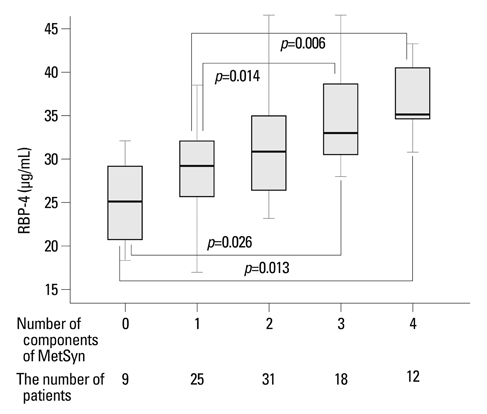Yonsei Med J.
2012 Nov;53(6):1211-1215. 10.3349/ymj.2012.53.6.1211.
Serum Retinol-Binding Protein-4 Levels Are Increased in HIV-Infected Subjects with Metabolic Syndrome Receiving Highly Active Antiretroviral Therapy
- Affiliations
-
- 1Department of Internal Medicine and AIDS Research Institute, Yonsei University College of Medicine, Seoul, Korea. shhan74@yuhs.ac
- 2Department of Internal Medicine and Endocrine Research Institute, Yonsei University College of Medicine, Seoul, Korea.
- KMID: 1414266
- DOI: http://doi.org/10.3349/ymj.2012.53.6.1211
Abstract
- Metabolic syndrome is an important long term complication in chronic asymptomatic HIV-infected subjects under highly active antiretroviral therapy (HAART), because it can contribute to morbidity and mortality via cardiovascular disease (CVD). Therefore, a predictive marker for early detection of metabolic syndrome may be necessary to prevent CVD in HIV-infected subjects. Retinol-binding protein-4 (RBP-4) has been shown to be associated with metabolic syndrome in various non-HIV-infected populations. We performed a cross-sectional study to evaluate whether serum RBP-4 levels are correlated with metabolic syndrome in HIV-infected subjects receiving HAART. In total, 98 HIV-infected Koreans who had been receiving HAART for at least 6 months were prospectively enrolled. Metabolic syndrome was diagnosed according to the Adult Treatment Panel III criteria, and serum RBP-4 concentrations were measured using human RBP-4 sandwich enzyme-linked immunosorbent assay. Serum RBP-4 levels were significantly higher in HIV-infected subjects receiving HAART with metabolic syndrome (n=33, 33.9+/-7.7 microg/mL) than in those without it (n=65, 29.9+/-7.2 microg/mL) (p=0.012). In multivariate linear regression analysis, the number of components of metabolic syndrome presented and waist circumference were independently, significantly correlated with RBP-4 (p=0.018 and 0.030, respectively). In conclusion, we revealed a strong correlation between RBP-4 and the number of components of metabolic syndrome in HIV-infected subjects receiving HAART.
MeSH Terms
Figure
Reference
-
1. Barbaro G. Highly active antiretroviral therapy-associated metabolic syndrome: pathogenesis and cardiovascular risk. Am J Ther. 2006. 13:248–260.
Article2. Bonfanti P, Giannattasio C, Ricci E, Facchetti R, Rosella E, Franzetti M, et al. HIV and metabolic syndrome: a comparison with the general population. J Acquir Immune Defic Syndr. 2007. 45:426–431.3. Estrada V, Martínez-Larrad MT, González-Sánchez JL, de Villar NG, Zabena C, Fernández C, et al. Lipodystrophy and metabolic syndrome in HIV-infected patients treated with antiretroviral therapy. Metabolism. 2006. 55:940–945.
Article4. Grinspoon S, Carr A. Cardiovascular risk and body-fat abnormalities in HIV-infected adults. N Engl J Med. 2005. 352:48–62.
Article5. Cho YM, Youn BS, Lee H, Lee N, Min SS, Kwak SH, et al. Plasma retinol-binding protein-4 concentrations are elevated in human subjects with impaired glucose tolerance and type 2 diabetes. Diabetes Care. 2006. 29:2457–2461.
Article6. Graham TE, Yang Q, Blüher M, Hammarstedt A, Ciaraldi TP, Henry RR, et al. Retinol-binding protein 4 and insulin resistance in lean, obese, and diabetic subjects. N Engl J Med. 2006. 354:2552–2563.
Article7. von Eynatten M, Lepper PM, Liu D, Lang K, Baumann M, Nawroth PP, et al. Retinol-binding protein 4 is associated with components of the metabolic syndrome, but not with insulin resistance, in men with type 2 diabetes or coronary artery disease. Diabetologia. 2007. 50:1930–1937.
Article8. Lee JW, Im JA, Lee HR, Shim JY, Youn BS, Lee DC. Visceral adiposity is associated with serum retinol binding protein-4 levels in healthy women. Obesity (Silver Spring). 2007. 15:2225–2232.
Article9. Aeberli I, Biebinger R, Lehmann R, L'allemand D, Spinas GA, Zimmermann MB. Serum retinol-binding protein 4 concentration and its ratio to serum retinol are associated with obesity and metabolic syndrome components in children. J Clin Endocrinol Metab. 2007. 92:4359–4365.
Article10. Qi Q, Yu Z, Ye X, Zhao F, Huang P, Hu FB, et al. Elevated retinol-binding protein 4 levels are associated with metabolic syndrome in Chinese people. J Clin Endocrinol Metab. 2007. 92:4827–4834.
Article11. National Cholesterol Education Program (NCEP) Expert Panel on Detection, Evaluation, and Treatment of High Blood Cholesterol in Adults (Adult Treatment Panel III). Third Report of the National Cholesterol Education Program (NCEP) Expert Panel on Detection, Evaluation, and Treatment of High Blood Cholesterol in Adults (Adult Treatment Panel III) final report. Circulation. 2002. 106:3143–3421.12. Fan JG, Peng YD. Metabolic syndrome and non-alcoholic fatty liver disease: Asian definitions and Asian studies. Hepatobiliary Pancreat Dis Int. 2007. 6:572–578.13. National Institutes of Health. Division of AIDS (DAIDS) revised toxicity tables for grading severity of adult and pediatric adverse experiences, US National Institutes of Health DAIDS HIV Vaccine and Research Program, Version 1.0. 2004. 12. Washington, DC: Available at http://rsc.tech-res.com/safetyandpharmacovigilance/gradingtables.aspx.14. Friedewald WT, Levy RI, Fredrickson DS. Estimation of the concentration of low-density lipoprotein cholesterol in plasma, without use of the preparative ultracentrifuge. Clin Chem. 1972. 18:499–502.
Article15. Bozzette SA, Ake CF, Tam HK, Chang SW, Louis TA. Cardiovascular and cerebrovascular events in patients treated for human immunodeficiency virus infection. N Engl J Med. 2003. 348:702–710.
Article16. Mary-Krause M, Cotte L, Simon A, Partisani M, Costagliola D. Clinical Epidemiology Group from the French Hospital Database. Increased risk of myocardial infarction with duration of protease inhibitor therapy in HIV-infected men. AIDS. 2003. 17:2479–2486.
Article17. Sweeney LL, Brennan AM, Mantzoros CS. The role of adipokines in relation to HIV lipodystrophy. AIDS. 2007. 21:895–904.
Article18. Kolovou GD, Anagnostopoulou KK, Salpea KD, Mikhailidis DP. The prevalence of metabolic syndrome in various populations. Am J Med Sci. 2007. 333:362–371.
Article19. Niwa Y, Ishikawa S, Gotoh T, Kayaba K, Nakamura Y, Kajii E. Metabolic syndrome mortality in a population-based cohort study: Jichi Medical School (JMS) Cohort Study. J Epidemiol. 2007. 17:203–209.
Article
- Full Text Links
- Actions
-
Cited
- CITED
-
- Close
- Share
- Similar articles
-
- Two cases of systemic inflammatory reactions after highly active antiretroviral therapy in HIV infected patients with tuberculosis
- Herpes Zoster Immune Reconstitution Inflammatory Syndrome in a HIV-infected Patient: Case Report and Literature Review
- Leptin in Relation to the Lipodystrophy-Associated Metabolic Syndrome
- Acute human immunodeficiency virus infection managed with highly active antiretroviral therapy
- Non-AIDS Morbidity among HIV Patients


